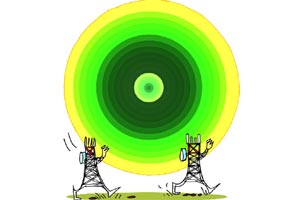More than one and a half years after the Telecom Regulatory Authority of India submitted the working guidelines on spectrum trading, the Union Cabinet on Wednesday approved it, thus providing space for some of the country’s weaker operators to exit the business by selling their spectrum to bigger operators who are on the look out for more radio waves as they launch newer services like 4G and are getting overstretched by rising subscriber base as well growth in data usage.
Though technically many players can buy spectrum through trading barring the odd few here and there despite the cap on trading — operators cannot hold spectrum more than 25% of the total assigned in a circle and 50% in a given band — practically speaking there would be a constraint. This is because there are a large number of buyers like Bharti Airtel, Vodafone, Idea Cellular and Reliance Jio Infocomm but very few sellers with matching spectrum, like Videocon and Aircel in some circles. As a result, the actual trades may be few because of supply side constraints.
However, there could be a possibility of Videocon selling its spectrum in most circles and even Aircel can sell its spectrum, especially in the 2300 MHz band in some circles to possible buyers like Vodafone and Idea as they don’t have spectrum in this band but need it for their 4G services. Aircel has spectrum in the 2300 MHz band in eight circles, which it acquired in 2010, but still has not commenced services.
However, the biggest dampener on trading pacts or a factor that would make it costly is the double charge companies would have to pay for such agreements. The seller of the spectrum would have to pay to the government licence fee and spectrum usage charge (SUC) amounting to 13% of its adjusted gross revenue on the amount received from the buyer even if its holds spectrum acquired through auctions. The buyer would have to pay a transactional charge to the government which will be 1% of the transactional amount or 1% of the prescribed market rate, whichever is higher. The industry had urged the government not to charge licence fee and SUC from the proceeds of the seller as it amounts to imposing a charge twice over, but the government has rejected it.
Among the realm of possibilities, in Delhi and Mumbai barring Bharti, other operators can enter into trading pacts despite the cap. Bharti gets stuck because it has spectrum in almost all the bands, 1800, 900, 2100 and 2300 MHz, which increases its total quantum. Theoretically, there can be trading of spectrum in Delhi between Vodafone and Idea, Vodafone and RCom and Vodafone and MTNL. Similarly, in Mumbai too similar trading can take place between operators with the only exception that Vodafone cannot buy more spectrum in the 900 MHz band there because it has 50% of the spectrum in that band.
Though caps would act as an irritant in some cases, telecom minister Ravi Shankar Prasad has constituted a committee to review them. However, the removal of caps would be more beneficial in spectrum sharing, which the government approved last month, as there the operators can pool their spectrum and strengthen cell sites in congested areas.
The biggest positive feature of spectrum trading is that operators do not need to take any prior permission from the government for such deals but would require to just inform it 45 days in advance along with an undertaking that they are not in breach of any licensing condition. Further, trading would be permitted only on a pan-LSA (licensed service area) basis and cannot be done for a part of a telecom circle. If trading is done for spectrum administratively allocated spectrum, the market-determined rate for it would have to be paid to the government.
A lock-in period of two years would be applicable on the spectrum that an operator acquires through trading before it can trade in it again.



